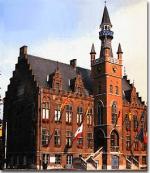
picture Maldegem.
Carzeele
Caeseele
Van Caeseele
Our family Cayzeele, Caeseele, with or without the prefix van is probably deduced from an ancient region named carzeele.
It was a property that in the twelfth century that belonged to a lord. This lord was a subject of the landlord. In the eleventh century we found a tenth that was to give to the diocese of Doornik: Decima de Casale.
This property was situated in Waregem., Westvlaanderen, Belgium.
The name Carzeele has changed in the past.
The r is pronounced as y in this region. Thus the name came Cayseele.
In other regions f.e. Brugge (Bruges) it became caeseele.
There are several meaningsof the word.
It could be:
CARZEELE = ZEELE, village, land, place.
KAARDEN = Dutch with the meaning of wool-card, an outil in the production of wool.
CARS = also a town in Turkey. But this is certainly an imagination. The person could have gone to crusade and received land from the duke
CARS ZEELE = property of Caers, the owner of the property named CAERS?
We do not know the exact meaning.
In the 14th century, the descendants are found in Gent, Brugge, Waregem, Oudenaarde, and Kortrijk.
In the 15th and 16th it was in the same towns.
Almost all descendants now living are descendants of Josse VANCAYSEELE of Poperinge.
The name VANCAESEELE descends from Philippus VAN CAESEELE in the region of Maldegem, Belgium, also.
Carzeele Journaal
Our organisation
We are an organization interested in genealogy. We do research on the name Vancayseele, Vancaeseele, Vancaeyzeele, Cayzeele, and other orthographies.
Now we already know that the name has its roots in the country of Waregem, West Vlaanderen, Belgium. There was a Feudal System. The economy was based on agriculture. Most of the people lived isolated in the country where they were working most of the day. The control over such a society was often in the hands of a small group, the landlords. The farmers were working and living in a region owned by a landlord. In exchange for their labor the farmers obtained shelter, a small part of the profit, and protection. In a feudal society people do not take active part in the society.
Carzeele (goetkin te caeyseele)
In the XVI century the count already had land that was cultivated and under a certain possession of a smaller landlord. In Dutch we speak about lenen and achterlenen.
The landlord earned rente, rents. He received tienden, Latin, decima, tenths also. The mayor was the baljuw. He was officer of the court.
The king was primarily a warlord and had power to distribute land conquered by his troops among the dukes. They in turn gave it to the knights. Trade that had once flourished around the Mediterranean Sea and in Western Europe declined, money barely existed anymore. There was no economical ground to raise taxes in significant amounts. Instead, farmers had to deliver 10% of their crops to the landowners (noblemen or monasteries): tenthsere often also obliged to soccage (compulsory labor) for several days per year.
The decima Casale was delivered to the bishop of Doornik (Tournai) in the XIIth century.
The land that belong to the Chaptel of Doornik is known and we certainly can write that Caseele was a part of t Vijve-Ainsche. This land had three parts in the XIIth century: Steenbeke, Tategem, and Caseele. They are mentioned in a donation 22/2/964(the Latin text write et Stenbeca et Tatingehim cum ecclesia et Potingehim secus flovio Viva et forestum Methela ubi possunt saginari mille porci et Sausele ubi
. The gift was the manner of the lord to win the landlords for him.
Later we find great Caseele. It was at one time the greatest farm of Waregem. Now the address is: Caseelstraat nr. 76.
The landlord had 7 schepenen (is not a sheriff, but the persons who sit in the bench of justice a certain judges), 6 achterlenen (lords who are subject of the landlord) and several rents.
In the 15th century the landlord was no longer named Caseele but vande Wostine.
The small Caseele is a separated land with one achterleen.
21-09-2005 om 19:16
geschreven door Carzeele
|

